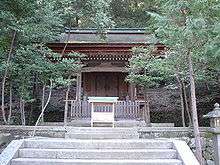Tsukuyomi-no-Mikoto
| Part of a series on |
| Shinto |
|---|
 |
| Practices and beliefs |
| Shinto shrines |
| Notable Kami |
| Important literature |
|
| See also |
|
|

Tsukuyomi-no-Mikoto or Tsukiyomi (月読 also known as Tsukiyomi-no-mikoto, 月読尊), is the moon god in Shinto and Japanese mythology. The -no-mikoto ending is a common honorific suffix for the names of gods, of similar meaning to "the grand, the great, the exalted".[1] The name "Tsukuyomi" is a compound of the Old Japanese words tsuku (月, "moon, month", becoming modern Japanese tsuki) and yomi (読み, "reading, counting").[1] The Nihon Shoki mentions this name spelled as Tsukuyumi (月弓, "moon bow"), but this yumi is likely a variation in pronunciation of yomi (読み, "reading, counting").[1] An alternate interpretation is that his name is a combination of tsukiyo (月夜, "moonlit night") and mi (見, "looking, watching"). "Yomi" may also refer to the Japanese underworld, though this interpretation is unlikely; given that he was created from the washing of Izanagi-no-Mikoto's right eye after his visit to Yomi, this alternate interpretation of Tsukuyomi's name creates an amusing pun.

Unlike the myths of ancient Greece or Rome, the Japanese moon deity is male. This is clear in the earliest mentions in sources such as the Kojiki and the Man'yōshū, where Tsukuyomi's name is sometimes rendered as Tsukuyomi Otoko (月讀壮士, "moon reading man")[2] or as Tsukihito Otoko (月人壮士, "moon person man").[3]
Tsukuyomi was the second of the "three noble children" (三貴子, みはしらのうずのみこ, Mihashira-no-uzunomiko) born when Izanagi-no-Mikoto, the god who created the first land of Onogoro-shima, was cleansing himself of his sins while bathing after escaping the underworld and the clutches of his enraged dead wife, Izanami-no-Mikoto. Tsukuyomi was born when he washed out of Izanagi's right eye.[4] However, in an alternate story, Tsukuyomi was born from a mirror made of white copper in Izanagi's right hand.
After climbing a celestial ladder, Tsukuyomi lived in the heavens, also known as Takamagahara, with his sister Amaterasu Ōmikami, the sun goddess, who also later became his wife.
Tsukuyomi angered Amaterasu when he killed Uke Mochi, the goddess of food. Amaterasu once sent Tsukuyomi to represent her at a feast presented by Uke Mochi. The goddess created the food by turning to the ocean and spitting out a fish, then facing a forest and spitting out game, and finally turning to a rice paddy and coughing up a bowl of rice. Tsukuyomi was utterly disgusted by the fact that, although it looked exquisite, the meal was made in a disgusting manner, and so he killed her.[4]
Soon, Amaterasu learned what happened and she was so angry that she refused to ever look at Tsukuyomi again, forever moving to another part of the sky. This is the reason that day and night are never together. In later versions of this myth, Uke Mochi is killed by Susanoo instead.
References
- 1 2 3 1988, 国語大辞典(新装版) (Kokugo Dai Jiten, Revised Edition) (in Japanese), Tōkyō: Shogakukan
- ↑ c. 759: Man'yōshū, volume 7, poem 1372; in Old Japanese. Text available online here.
- ↑ c. 759: Man'yōshū, volume 10, poem 2010; in Old Japanese. Text available online here.
- 1 2 Roberts, Jeremy (2010). Japanese Mythology A To Z (PDF) (2nd ed.). New York: Chelsea House Publishers. ISBN 978-1-60413-435-3.
External links
 Media related to Tsukuyomi-no-Mikoto at Wikimedia Commons
Media related to Tsukuyomi-no-Mikoto at Wikimedia Commons

